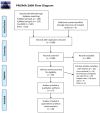The risk of new-onset diabetes in antidepressant users - A systematic review and meta-analysis
- PMID: 28759599
- PMCID: PMC5536271
- DOI: 10.1371/journal.pone.0182088
The risk of new-onset diabetes in antidepressant users - A systematic review and meta-analysis
Abstract
Background: Antidepressant Drugs (ADs) are among the most commonly prescribed medications in developed countries. The available epidemiological evidence suggests an association between AD use and higher risk of developing type 2 diabetes mellitus. However, some methodological issues make the interpretation of these results difficult. Moreover, very recent studies provided conflicting results. Given the high prevalence of both diabetes and AD use in many countries, clarifying whether this association is causal is of extreme relevance for the public health. The aim of the present study is to provide an up-to-date evaluation of the evidence in support of a causal role of ADs in inducing diabetes.
Methods and findings: A systematic literature search was conducted to identify relevant studies in MEDLINE (PubMed), PsycINFO, and International Pharmaceutical Abstracts (IPA) through 31st December 2016. Only studies assessing the incidence of new-onset diabetes in subjects treated with ADs were included. Results were pooled using a random-effects meta-analysis. Moreover, we extensively reviewed the role of the different sources of bias that have been proposed to explain the association between AD and diabetes. Twenty studies met the inclusion criteria. In the meta-analysis, the association between AD use and diabetes was still evident after the inclusion of the recent negative studies [pooled relative risk = 1.27, 95% confidence interval (CI), 1.19-1.35; p<0.001]. None of the biases proposed by previous authors seemed able to fully explain the observed association.
Conclusions: This updated meta-analysis confirms the association between AD use and incident diabetes. It still remains a matter of debate whether single ADs exert a different effect on the risk of diabetes. Given the possible heterogeneity, we suggest that a classification of ADs according to their pharmacological profiles could be useful in better elucidating the nature of this association.
Conflict of interest statement
Figures


References
-
- Mojtabai R, Olfson M. National trends in long-term use of antidepressant medications: results from the U.S. National Health and Nutrition Examination Survey. J Clin Psychiatry. 2014; 75(2): 169–77. doi: 10.4088/JCP.13m08443 - DOI - PubMed
-
- Kantor ED, Rehm CD, Haas JS, Chan AT, Giovannucci EL. Trends in Prescription Drug Use Among Adults in the United States From 1999–2012. JAMA. 2015; 314(17): 1818–31. doi: 10.1001/jama.2015.13766 - DOI - PMC - PubMed
-
- Global Burden of Disease Study 2013 Collaborators. Global, regional, and national incidence, prevalence, and years lived with disability for 301 acute and chronic diseases and injuries in 188 countries, 1990–2013: a systematic analysis for the Global Burden of Disease Study 2013. Lancet. 2015; 386(9995): 743–800. doi: 10.1016/S0140-6736(15)60692-4 - DOI - PMC - PubMed
-
- Andersohn F, Schade R, Suissa S, Garbe E. Long-term use of antidepressants for depressive disorders and the risk of diabetes mellitus. Am J Psychiatry. 2009; 166(5): 591–8. doi: 10.1176/appi.ajp.2008.08071065 - DOI - PubMed
-
- Deuschle M. Effects of antidepressants on glucose metabolism and diabetes mellitus type 2 in adults. Curr Opin Psychiatry. 2013; 26(1): 60–5. doi: 10.1097/YCO.0b013e32835a4206 - DOI - PubMed
Publication types
MeSH terms
Substances
LinkOut - more resources
Full Text Sources
Other Literature Sources
Medical
Miscellaneous

